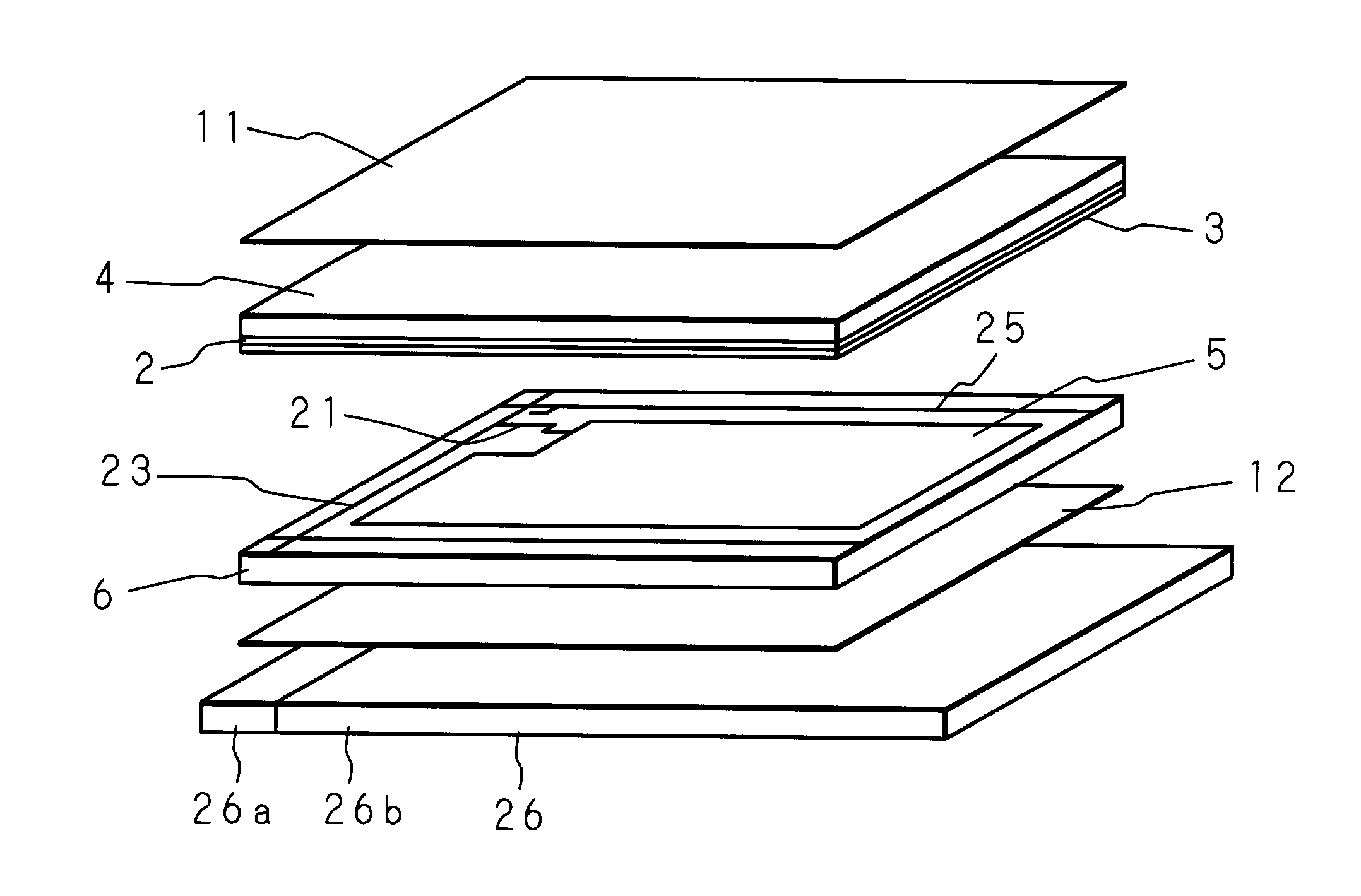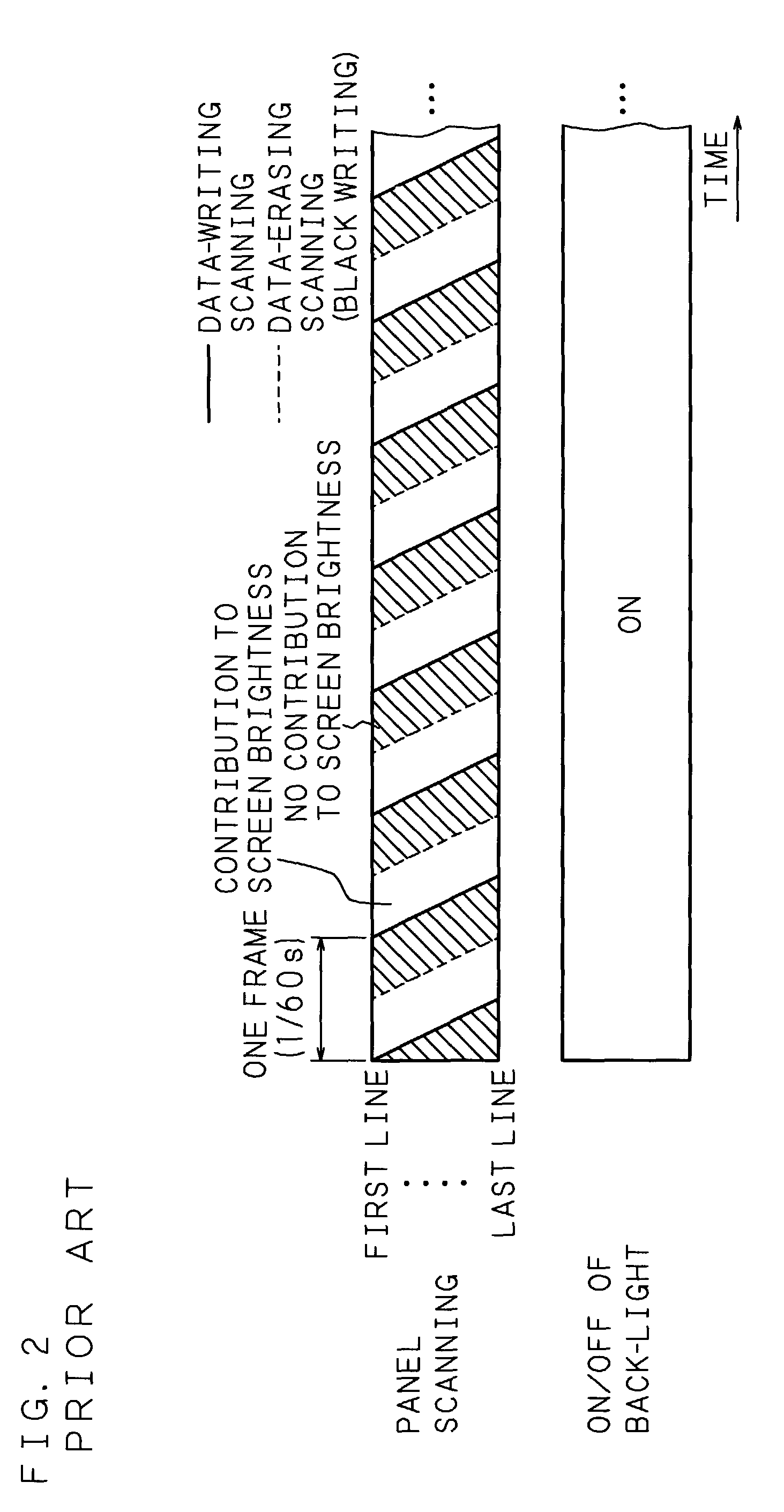Driving method of liquid crystal display device and liquid crystal display device
a technology of liquid crystal display device and driving method, which is applied in the direction of static indicating device, instruments, etc., can solve the problems of high power consumption of backlight, low production cost of stn type liquid crystal display device, and inability to display moving images. achieve the effect of improving light utilization efficiency
- Summary
- Abstract
- Description
- Claims
- Application Information
AI Technical Summary
Benefits of technology
Problems solved by technology
Method used
Image
Examples
first embodiment
[0056]First, the liquid crystal panel 1 shown in FIGS. 4 and 5 was fabricated as follows. After washing a TFT substrate having the pixel electrodes 5 (800×600 pixels with a diagonal length of 12.1 inches) and a common electrode substrate having the common electrode 2 and the RGB color filter / black matrix 3, they were coated with polyimide and then baked for one hour at 200° C. to form the alignment films 7 and 8 made of about 200 Å thick polyimide films.
[0057]Further, these alignment films 7 and 8 were rubbed with a cloth made of rayon, and stacked with a gap being maintained therebetween by the spacers 10 made of silica having an average particle size of 1.6 μm so as to fabricate an empty panel. A ferroelectric liquid crystal material composed mainly of naphthalene-based liquid crystals (for example, a material disclosed by A. Mochizuki, et. al.: Ferroelectrics, 133,353 (1991)) was sealed in this empty panel to form the liquid crystal layer 9. The magnitude of spontaneous polarizat...
second embodiment
[0062]A liquid crystal display device was constructed by stacking the liquid crystal panel 1 fabricated under the same conditions as in the first embodiment and the back-light 26 formed of LEDs of easy switching.
[0063]In addition, according to the drive sequences shown in FIGS. 7 and 8, the TFTs 21 of the respective pixel electrodes 5 were driven on a line by line basis to apply a voltage corresponding to the image data. The selection period of each line was made 7 μs. The data-erasing scanning was performed twice.
[0064]The maximum applied voltage to the liquid crystal corresponding to the image data was made (Vcom+7) V, the first applied voltage to the liquid crystal by batch selection of all the pixel electrodes (batch selection of all the lines) during erasure was made (Vcom−8) V, and the second applied voltage was made equal to Vcom. Moreover, a time interval of 500 μs in which the liquid crystal can respond sufficiently was set between the first voltage application and the seco...
third embodiment
[0067]Like the first embodiment, after washing a TFT substrate having the pixel electrodes 5 (800×600 pixels with a diagonal length of 12.1 inches) and a common electrode substrate having the common electrode 2 and the RGB color filter / black matrix 3, they were coated with polyimide and then baked for one hour at 200° C. to form the alignment films 7 and 8 made of about 200 Å thick polyimide films.
[0068]Further, these alignment films 7 and 8 were rubbed with a cloth made of rayon, and stacked with a gap being maintained therebetween by the spacers 10 made of silica having an average particle size of 1.6 μm so as to fabricate an empty panel. A ferroelectric liquid crystal material composed mainly of naphthalene-based liquid crystals (for example, a material disclosed by A. Mochizuki, et. al.: Ferroelectrics, 133,353 (1991)) was sealed in this empty panel to form the liquid crystal layer 9. The magnitude of spontaneous polarization of the sealed ferroelectric liquid crystal material w...
PUM
 Login to View More
Login to View More Abstract
Description
Claims
Application Information
 Login to View More
Login to View More - R&D
- Intellectual Property
- Life Sciences
- Materials
- Tech Scout
- Unparalleled Data Quality
- Higher Quality Content
- 60% Fewer Hallucinations
Browse by: Latest US Patents, China's latest patents, Technical Efficacy Thesaurus, Application Domain, Technology Topic, Popular Technical Reports.
© 2025 PatSnap. All rights reserved.Legal|Privacy policy|Modern Slavery Act Transparency Statement|Sitemap|About US| Contact US: help@patsnap.com



